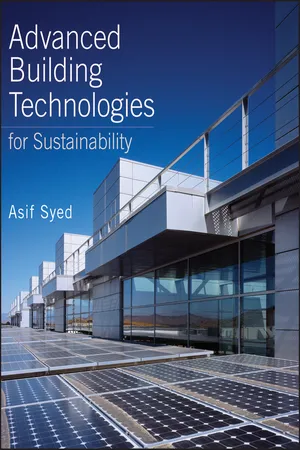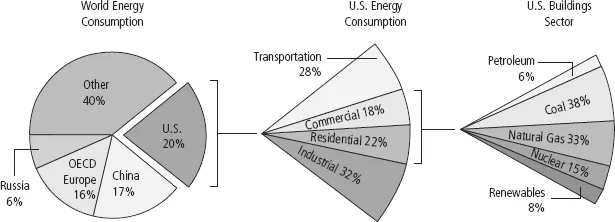![]()
CHAPTER 1
Sustainability and Energy
BUILDING ENERGY CONSUMPTION IS A SIGNIFICANT PORTION of the total energy used worldwide. In the United States, buildings use about 40 percent of the total energy consumed and about 68 percent of the electricity produced. Buildings are responsible for 38 percent of carbon emissions.1 Buildings account for the highest carbon emissions, followed by transportation and industry. Buildings will continue to grow as the population of the world grows. The current world population according to the U.S. Census Bureau is 6.9 billion2, and is projected to grow from 6.1 billion in 2000 to 8.9 billion in 2015.3 The growth in population creates demand for new buildings: residential, educational, commercial (office and retail), health-care, and manufacturing. Growth of the buildings is going to happen, whether we like it or not. These new buildings will increase the demand for energy, increasing the cost of energy. Additionally, the growth of buildings will increase the global carbon emissions.
Economic development is essential to the social, political, and economic order of the world, and building construction is a big part of the economic development of all the world’s countries. With almost 9 million people employed in construction (per 2008 statistics), it is one of the largest industries. The wages of construction workers are relatively high. The construction industry also creates and promotes small business, as more than 68 percent of construction-related establishments consist of fewer than five people, and a large number of workers in construction are self-employed.4 Economic development and growth will continue to add new buildings. The new buildings present an opportunity to adopt new technologies and reduce the increase in demand for energy, thus containing the cost of energy. Slowing down the increase in energy consumption through advanced technologies also reduces carbon emissions, reducing the impact of development on the environment.
In the 1300s, Arab historian Ibn Khaldun defined or described economic growth as:
When civilization or population increases, the available labor or manpower increases. In turn, luxury increases in correspondence with the increasing profit, and the customs and needs of luxury increase. Crafts are created to obtain luxury products. The value realized from them increases, and, as a result, profits are again multiplied. And so it goes with the second and third increase. All the additional labor serves luxury and wealth, in contrast to the original labor that served the necessity of life.
Versions or parts of Ibn Khaldun’s theory are still valid in modern times, which means that economic development is imminent and ongoing. Construction of new buildings is a big part of economic development and will continue, as a result of:
- Growth due to increase in population
- Higher rate of growth in the developing countries due to globalization
- A very high disparity between the per capita energy consumption and building footprint in developing countries vs. developed countries
- Trying to catch up with developing countries puts additional demand above and beyond normal population growth.
New technologies can contribute to slowing down the growth of energy consumption, without slowing down the economic growth that is essential to maintain the world’s social, political, and economic order. The goal of energy savings in buildings is to reduce the rate of growth of energy consumption, while maintaining economic growth. World economic growth is expected to grow 49 percent by 2035, as reported by the United States Energy Information Administration report International Energy Outlook 2010.5
Continuing at this rate of growth and development with the current practices of using energy, which primarily comes from using fossil fuels, has two diametrically opposite forces. On one side is growing more, traveling more, having more space, and brighter and bigger cities. On the other side, there are limited or declining resources. Effectively utilizing resources is essential or soon it will take more than one earth to meet the growing needs for resources. “Soon” is now, according to the Global Footprint Network, an alliance of scientists who calculate that in 10 months, humanity will have exhausted nature’s yearly budget.6
Growth in the developing countries will occur at a much higher rate than in the developed Western world. The U.S. Energy Information Administration has made two forecasts: high economic growth (63%) and low economic growth (37%). With higher growth rates in the developing world or the newly industrialized countries, the median growth of 50 percent is very likely, based on the growth rate and energy consumption growth of India and China. To a certain degree, India’s and China’s energy consumption growth will not put all the pressure on fossil fuels, given their high level of growth in nuclear power plants. According to the World Nuclear Association,7 nuclear power generation has the highest growth in Asia. China, Japan, South Korea, and India are the countries with the largest number of nuclear power plants planned; more than eighty-four nuclear power plants are planned in these countries. The recent tsunami in Japan has exposed the vulnerability of nuclear power generation. The damages from the tsunami are evident, and several countries are reevaluating their dependence on nuclear power. Every country is evaluating whether the benefits are worth the risks. It is too soon to predict (1) the pressures that the increase in demand for energy will put on the prices of clean-burning fossil fuels or (2) the huge environmental impact of growth in conventional coal power plants.
The worldwide economic growth will put intense pressure on energy resources and will increase the demand for energy and fossil fuels. In the current methodology of energy production, energy and fossil fuels are almost synonymous, as currently fossil fuel is the major source of energy. Fossil fuels such as oil, coal, and natural gas account for more than 85 percent of the energy used in the United States.8 The same fossil fuels produce about 70 percent of the electricity. The other 30 percent breaks down as 20 percent from nuclear power plants, 6 percent from hydro power plants, and 4 percent from renewables such as solar and wind power.9 Making improvements to buildings’ energy use and efficiency can generate significant savings in energy and fossil fuel costs. The majority of fossil fuels are a globally fluid commodity that flows to the place of demand or to the highest bidder. The fluidity of the fuel creates a global demand. The increase in demand is much higher in the developing countries.
Potential opportunities exist to make improvements to buildings in the mechanical, electrical, and plumbing (MEP) systems to improve their energy efficiency. There are currently available technologies that are cost effective and can reduce energy consumption by a significant amount. According to guidelines published by the American National Standards Institute (ANSI), the American Society of Heating, Refrigerating and Air-Conditioning Engineers (ASHRAE), and the Illuminating Engineering Society of North America (IESNA), almost 50 percent of energy can be reduced in office buildings.10 The most common standard used the world over, and adopted by most states in the United States is the ANSI/ASHRAE/IESNA Standard 90.1. The same professional organizations that wrote Standard 90.1 have also written design guides on how to achieve up to 50 percent energy savings over their own standards. Clearly, from these publications, there is evidence that there is significant opportunity to reduce energy in buildings. According to the United States Green Building Council (USGBC), a nonprofit organization that promotes sustainability in the building industry, there are potential technologies for existing and new buildings that can reduce energy use by 25 percent and carbon emissions by 30 percent.11 Moreover, there are opportunities to continue with growth and its economic benefits, but reduce the impact on energy resources, fossil fuels, and the environment by adopting the efficient technologies.
However, these technologies are not commonly known to the construction industry, including most design professionals, contractors, and manufacturers of building construction equipment and materials. Most of these new and advanced technologies or design approaches are basic and simple in nature, and easily understandable and implementable. However, they are different from the current popular practices employed by the building design industry, including design professionals, contractors, and building operators. There are a select few professionals, both architects and engineers, who are familiar with and can confidently design these new technologies or mechanical or electrical systems; however, for the majority of the construction industry, these are technologies they have only heard about or read about. The “unknown tec...



